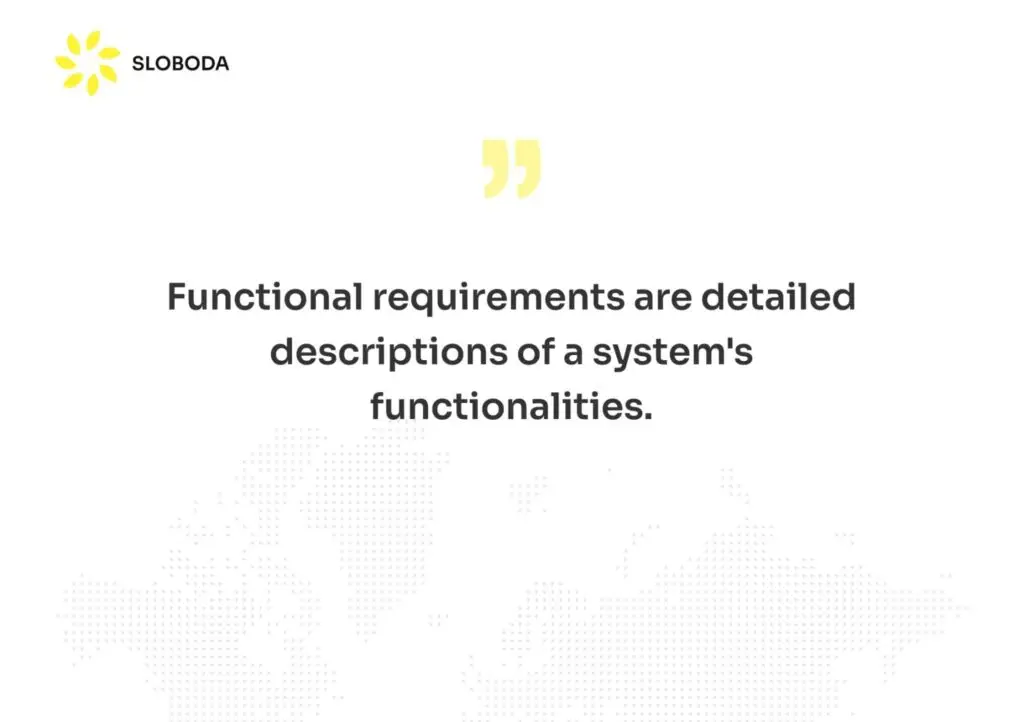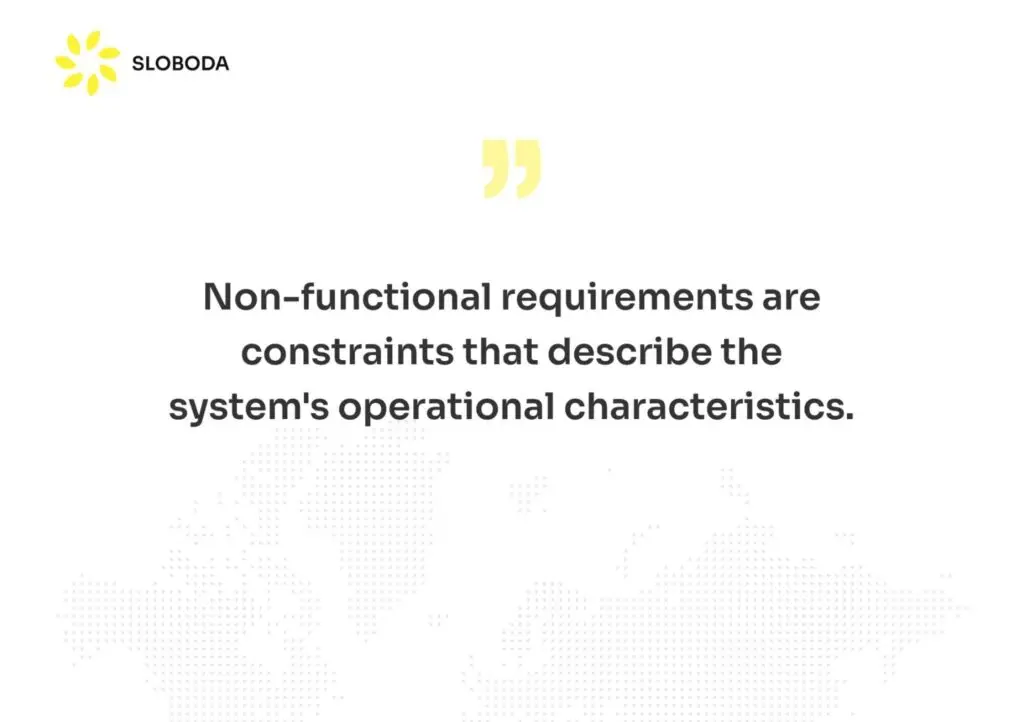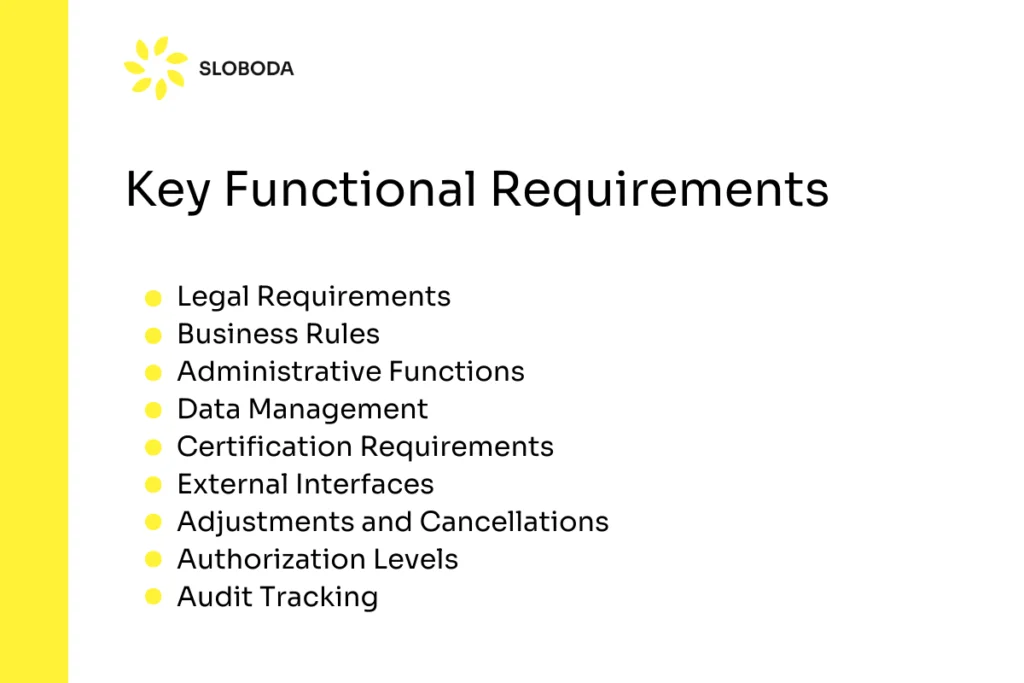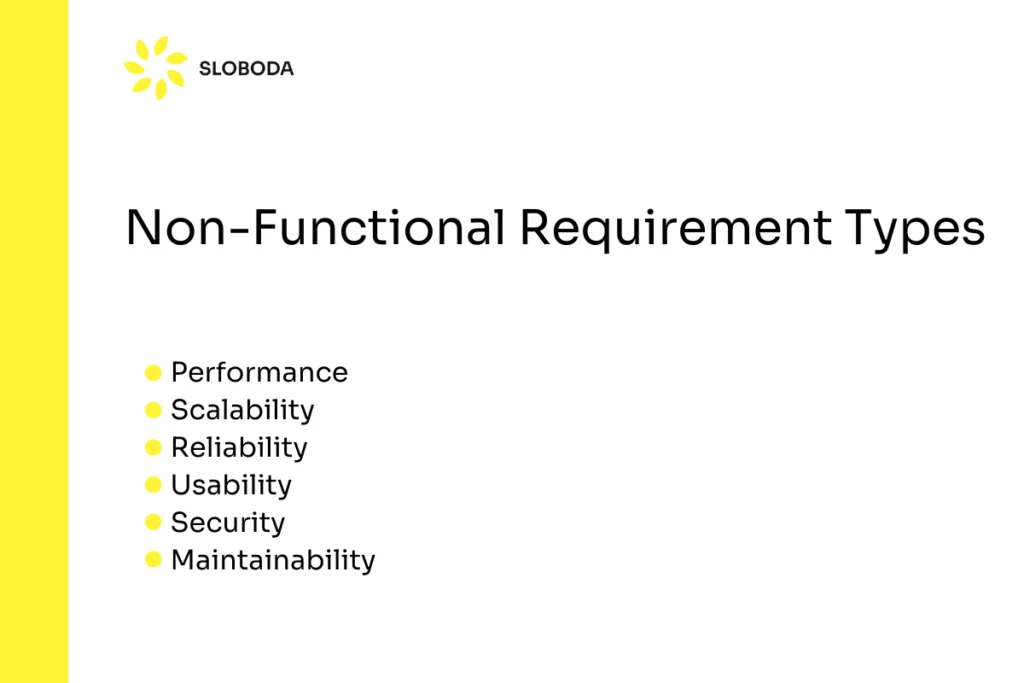Are you crafting software? It’s a bit like preparing a gourmet dish – it’s all about the right balance of ingredients. In the development world, these ingredients are your functional and non-functional requirements. Getting these right ensures your software functions smoothly and stands up to real-world use with flair.
Key Requirements and their Business Impact
Whether you’re building from scratch or tweaking an existing product, the success of software hinges significantly on how well it meets these core requirements.
Functional Requirements


Think of functional requirements as the ‘what’ of your project. They’re the essential tasks your software must handle. Let’s say you’re working on a project management tool. At a minimum, it needs to allow users to create tasks, assign them, and track progress. These are your bread and butter, the baseline from which everything else is measured.
Performance, or Nonfunctional Requirements


Then you have your non-functional requirements or the ‘how’ of the equation. It’s not enough that your project management tool can create tasks. How quickly does it load them? How does it handle data security? This is where you ensure your tool isn’t just functional – it’s also robust and dependable, even when a hundred teams log in simultaneously.
System Technical Requirements
Here, we’re diving deeper – into the technical bedrock of your software. These requirements define the operating systems, server specifications, and even third-party services your software needs to integrate with. It’s like setting up the stage before the actors walk on – it needs to be just right, or the whole performance could falter.
Specifications
Specifications are where you nail everything down. This document is your roadmap, detailing every requirement, every scenario, and how you plan to test them. It’s the script that everyone from developers to testers will follow, ensuring everyone is on the same page and moving toward the same goal.
The Role of Functional Requirements in Meeting User Expectations
Unraveling Functional Requirements
Functional requirements aren’t just technical jargon; they are the heartbeats of any software system. These are the specific operations that your application must perform to be useful—to turn it from a mere concept into a tool that people rely on every day.
Take, for example, a project management tool. The core functionality isn’t just about ticking off tasks. It’s about weaving together a user’s needs with seamless, intuitive interactions—ensuring that managers can assign tasks, track progress, and reassign duties with just a few clicks. Neglect these and your tool isn’t just ineffective—it’s practically ornamental.
The Spectrum of Functional Requirements


Functional requirements vary widely, each tailored to specific aspects of user interaction and system operations:
User Requirements: These are the touchpoints where users interact with the software. Like the buttons of an accordion, each press should produce a precise, expected response—be it opening a new project or sending out notifications.
System Requirements: Consider these the internal mechanics of that accordion. They ensure that every note plays correctly, that the bellows push air smoothly, and that the music flows harmoniously.
Interface Requirements: This is about ensuring all components—like different sections of an orchestra—work in sync. Each instrument, or software module, must complement the others, ensuring they produce a symphony, not a cacophony.
Examples of Functional Requirements
Let’s ground this discussion with some clear, tangible examples:
Marketplace Platform: Your shoppers need to navigate from login to checkout without a hitch. Functional requirements cover every step—ensuring the search bar suggests products based on user input, that images load quickly, and that the payment gateway is not just secure, but lightning fast.
Banking App: Here, functional requirements are about more than just transactions; they’re about peace of mind. Users expect to transfer funds, view balances, and even invest money with complete security and minimal fuss. Each function must be robust enough to handle sensitive information with supreme confidence.
CRM Software: For CRM systems, functionality means equipping sales teams with the tools to oversee client interactions effortlessly. From logging calls to predicting sales trends, each feature should enhance the user’s ability to connect with clients and drive sales.
Ready to Define Your Project Requirements?
Let’s Talk!
The Importance of Non-Functional Requirements for Software Excellence
Understanding and implementing non-functional requirements is pivotal for software applications’ robustness and operational efficiency. These aspects profoundly influence user satisfaction and system resilience.
Nonfunctional Requirements Meaning
Non-functional requirements articulate the conditions under which systems operate, emphasizing qualities like performance, usability, and security. They shape how software behaves in various environments, rather than what functions it performs.
These requirements enrich the software by enhancing key operational aspects such as performance, security, and scalability. Such improvements are vital, not just for ensuring that the application performs its tasks but for maintaining performance integrity under stress, safeguarding data, and handling user growth gracefully.
Types of Nonfunctional Requirements


Here’s a breakdown of the various types of non-functional requirements that impact software quality:
Performance: Addresses the speed and responsiveness of the application.
Security: Focuses on protecting the application and its data from unauthorized access and breaches.
Scalability: Ensures the application can expand its capacity as user demand grows.
Reliability: Concerns about the consistency of the application’s performance.
Usability: Involves the ease with which users can learn and use the software.
Nonfunctional Requirements Examples
To illustrate, consider these real-world applications of non-functional requirements:
Performance: A streaming service must ensure smooth video playback during peak viewership without buffering.
Security: Financial software protects sensitive user information with robust encryption protocols, ensuring compliance with global security standards.
Scalability: A social media platform scales seamlessly to accommodate sudden surges in traffic, such as during major events.
Reliability: An online payment system maintains transaction capabilities with minimal downtime, even during system upgrades.
Usability: An educational app provides an engaging, intuitive interface that adapts to various age groups and learning styles.
These examples demonstrate the critical role that non-functional requirements play in the lifecycle of a software system, ensuring that it not only functions correctly but also delivers a superior user experience and adapts well to changing demands.
Functional vs. Non-Functional Requirements: A Detailed Comparison
Exploring software development requires a deep understanding of the roles played by functional and non-functional requirements. These categories, crucial in their own right, support the creation of robust software.
Comparison of Functional vs. Non-Functional Requirements
| Aspect | Functional Requirements | Non-Functional Requirements |
| Purpose | Specify what the product must do, defining core functionalities | Outline how the product performs, focusing on operational quality |
| Outcome | Detail essential features necessary for user tasks and business goals | Highlight system properties that enhance usability and performance. |
| Focus | Address direct user requirements through system functions | Enhance the user experience by meeting performance and efficiency expectations |
| Mandatory Nature | Required for basic functionality and system operations | Desirable for optimal performance and enhanced quality |
| Source | Derived from direct user feedback and requirement gathering | Developed by technical teams based on system needs and standards |
| Testing | Conducted early to ensure functional integrity | Follows functional tests to validate system performance and durability |
| Examples | Includes user authentication and transaction processing | Covers scalability, reliability, and efficiency metrics |
Explaining the Differences
Functional requirements specify the operations a software system must perform. These are the tasks necessary for the software to function effectively. For instance, in a content management system, these requirements would include capabilities like creating, editing, and deleting articles. These operations directly impact how users interact with the system.
In contrast, non-functional requirements focus on the performance and usability of these operations. They ensure tasks are performed efficiently and include parameters such as speed, security, and interface design. These factors do not change the functions but improve the experience of using them.
The Interconnection of Functionality and Performance
The link between functional and non-functional requirements directly affects a software’s effectiveness and user satisfaction. While functional requirements ensure that the software can perform its intended tasks, non-functional requirements optimize these tasks to enhance user experience. For example, a banking app must not only secure transactions (functional) but also do so quickly and intuitively (non-functional).
Implications for Software Development
These categories guide the entire development process from the design phase to final testing. It is critical for developers to address both sets of requirements to build software that functions correctly and is user-friendly. This might mean revising initial plans based on test results to better meet both functional and non-functional standards.
Achieving a balance between these requirements is like tuning an instrument—ensuring both the accuracy of the notes and the quality of the sound. This balance enhances user satisfaction and makes the software competitive.
Properly addressing both functional and non-functional requirements ensures that software not only meets basic operational needs but also performs exceptionally, meeting broader user expectations and adapting to changing demands.
Why You Should Consider Documenting the Requirements


Understanding the importance of documenting requirements is essential for the success of any software development project. This practice can help mitigate risks and streamline the entire process.
Prevent Project Setbacks
Proper documentation can prevent numerous project setbacks. When requirements are clearly outlined from the beginning, everyone involved in the project has a clear understanding of what needs to be done. This clarity reduces the risk of misunderstandings and ensures that the development process runs smoothly, avoiding costly delays.
Guarantee System Performance Meets User Expectations
Documenting requirements ensures that the system’s performance aligns with user expectations. By clearly defining both functional and non-functional requirements, developers can create software that not only meets basic needs but also performs efficiently. This attention to detail helps in delivering a product that users find reliable and easy to use, increasing overall satisfaction.
Stay Within Budget
A well-documented set of requirements helps in staying within budget. Clear requirements allow project managers to accurately estimate the resources needed for development. This foresight prevents unforeseen expenses, helping to keep the project on track financially and avoiding budget overruns that can derail the project.
Discover How We Simplify Software Development
Contact Us
Having detailed requirements sharpens the focus of the project. It provides a roadmap for developers and stakeholders, ensuring that everyone is working towards the same goals. This focus helps in maintaining the project’s direction, avoiding scope creep, and ensuring that the end product aligns with the initial vision.
Identify Further Needs
Documentation also helps in identifying further needs that might arise during the development process. By having a clear record of the initial requirements, it becomes easier to spot gaps or additional features that could enhance the software. This proactive approach ensures that the final product is comprehensive and meets all user needs effectively.
Documenting requirements is a fundamental practice in software development that can lead to more efficient processes, better resource management, and a higher-quality end product.
Expert Tips for Requirements Gathering and Management
According to Forbes, software projects often fail due to unclear requirements and clients’ uncertain visions, making clear communication essential to project success. Getting the requirements right is a game-changer in software development. Let’s explore some expert tips that can make the process more effective and even enjoyable.
Adopt Industry Best Practices for Better Outcomes
Why struggle with trial and error when there are proven strategies at your disposal?
- Stakeholder Involvement: Imagine planning a big party without asking the guests what they like. Sounds risky, right? The same goes for software development. Engaging all stakeholders from the get-go ensures that the final product meets everyone’s expectations. Keep them in the loop—early and often.
- Prototypes and Mockups: Think of these as your project’s sneak previews. Just like movie trailers give a glimpse of the final film, prototypes, and mockups provide a visual idea of what’s being built. They help align everyone’s vision and minimize misunderstandings.
- Regular Reviews and Updates: Requirements are like living documents—they evolve. Regular reviews ensure they stay relevant and accurate. It’s like having regular health check-ups to catch potential issues before they become big problems.
- Traceability: Ever played a game of telephone where the message gets lost along the way? Traceability ensures that doesn’t happen with your project. It tracks each requirement from origin to implementation, making sure nothing slips through the cracks.
Importance of Precision in Requirements Documentation Tools and Techniques
Precision isn’t just about being picky—it’s about clarity and success.
- Detailed Specifications: Imagine building a piece of IKEA furniture without the instructions. You’d end up with a mess. Detailed, clear specifications prevent such chaos, providing a roadmap for what needs to be done.
- Use of Requirements Management Tools: Tools like Jira, Trello, or IBM Rational DOORS are like having a super-organized planner. They help keep track of everything, from version control to collaborative editing. It’s like having an extra brain that never forgets anything.
- Workshops and Brainstorming Sessions: Ever noticed how brainstorming with a group often leads to better ideas than thinking alone? Workshops pull in diverse perspectives, sparking innovative solutions and uncovering potential issues early on.
- Prioritization Techniques: Think of requirements like packing for a trip. You need to decide what’s essential (passport, clothes) and what’s nice to have (fancy shoes, extra snacks). Techniques like MoSCoW help sort out priorities, ensuring the critical items are tackled first.
Following these expert tips makes gathering and managing requirements more than just a checklist item. It’s about building a strong foundation for your project, much like constructing a sturdy base for a skyscraper. With clear, well-managed requirements, your project is set for success, standing tall and resilient against any challenges that come its way.
A Decision Maker’s Guide to Requirements Documentation
For those steering software projects, navigating the intricacies of requirements documentation can feel like wading through uncharted waters. But with the right approach, this process can be simplified and highly effective.
Simplify the Complexity of Requirements
Imagine trying to build a complex Lego set without the instruction manual. Daunting, right? That’s often what documenting requirements can feel like. The first step is to outline the key goals. What’s the project aiming to achieve? These goals act as your guiding star.
Break it down further into categories. Functional requirements are your nuts and bolts—these define what the system should do. Think of them as the engine parts that need to work for the car to run. Then there are non-functional requirements, which focus on the car’s performance—how smoothly it runs, how reliable it is, and how comfortable the ride feels.
Using plain language helps. Cut out the tech jargon. When everyone, from developers to stakeholders, can understand the requirements, the process becomes smoother. It’s like everyone playing a game with the same rulebook.
Clarify Requirements with Prototypes and Data Visualization (Tables and Diagrams)
Ever tried explaining how to assemble furniture over the phone? Nearly impossible, right? Prototypes serve as your visual guide, much like an IKEA manual—they offer a tangible sense of the final product. Stakeholders can interact with these models, identifying potential issues and suggesting improvements early in the process.
Data visualization tools are equally vital. Tables neatly organize information, making it easier to compare different requirements. Diagrams, such as flowcharts and ER diagrams, illustrate data flow and system relationships at a glance. Visual aids do more than enhance understanding—they align everyone’s perception. It’s easier to catch and correct misunderstandings when the entire picture is laid out clearly.
Conclusion
Tackling requirements documentation doesn’t need to be overwhelming.
By breaking down the complexities and using visual tools and prototypes, decision-makers can achieve clarity and precision. These methods not only streamline the process but also improve communication and understanding among all parties involved. In the end, this leads to a smoother development process and a product that meets user expectations more effectively.